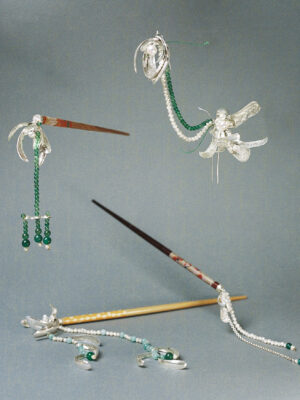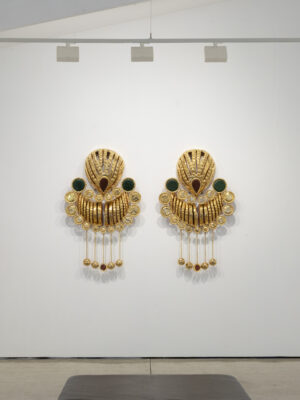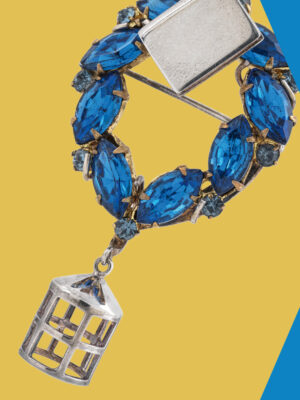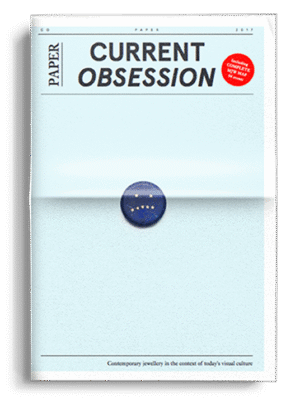Chinoiserie is a decorative style that peaked in popularity in the mid-18th century in Western Europe. In response to the vast popularity of Asian import wares, European merchants and designers began to produce their own objects ‘in the Chinese taste,’ which would later be coined chinoiserie.
While a decorative style might sound benign, I would argue that chinoiserie manifests as a significant phenomenon in the genealogy of European representations of exoticism and otherness. Contemporary Western/Euro-American representations of Asianness are informed by pre-existing signifiers of cultural difference. Chinoiserie is part of the history of this visual language. The values and narratives that were communicated and circulated via chinoiserie tell us much about the role of aesthetics, objects, and the sartorial in the emergence of racial and cultural difference.
As a person of mixed Chinese and Danish ethnicity, I have come to find kinship in chinoiserie objects. When I scroll through the wealth of search engine images depicting intricately ornamented lacquered cabinets, decorative wallpaper, and gaily coloured porcelain, I feel a familial resonance: ‘I am that folding screen with gilded ornaments,’ I think to myself, ‘I am that wooden bed frame decorated with dragons and peonies.’ Simultaneously distinctly Asian and distinctly European and neither, chinoiserie is a hybrid style. Defined by an elaborate, decorative appeal to the exotic and spectacular, the chinoiserie objects are shiny surfaces in which I can glimpse my own reflection.

___STEADY_PAYWALL___
When I scroll through the wealth of search engine images depicting intricately ornamented lacquered cabinets, decorative wallpaper, and gaily coloured porcelain, I feel a familial resonance: ‘I am that folding screen with gilded ornaments,’ I think to myself, ‘I am that wooden bed frame decorated with dragons and peonies.’
Chinoiserie describes a myriad of different objects from wallpaper to furniture to porcelain and even architecture. The designs are characterised by their highly ornamental motifs, as the style reached prominence in the period of the Rococo. It often includes imagery of pagodas or other ‘Chinese’ architecture, exotic-looking flora and fauna, and ‘Chinese’ looking people. The style was heavily influenced by contemporary trends in taste and fashion, developing in tandem with a growing demand for luxurious overseas items as well as ideas of empire and exoticism. The term ‘chinoiserie’ is a misnomer, denoting not fidelity to the cultural and historical specificity of adopted Chinese iconography, but instead to European ideas of exoticism that utilised signifiers from all over Asia. According to Stacey Sloboda, describing European objects inspired by Oriental things and aesthetics simply as ‘Chinese’ or ‘in the Chinese taste,’ as they were in eighteenth-century Britain, referred less to a stylistic and material origin and more to a developing notion of the Chinese as synonymous with concepts of hybridity, disorder, and illegibility, sometimes pleasurable, other times monstrous. (Sloboda 2014, 7)
Through an aesthetic of excess, ornament, and spectacle, chinoiserie would come to contribute to an Orientalist narrative, flattening the aesthetics of diverse and varied cultures into an amorphous ‘East’ for the purposes of marketability. As I study these centuries-old Western representations of ‘the Chinese taste’, I wonder how this narrative of perpetuating foreignness for the pleasure of Europeans manifests today. And further, how it manifests in me. What happens when, as a result of globalisation and displacement, Chinese subjects in the West come of age exposed to that same narrative?
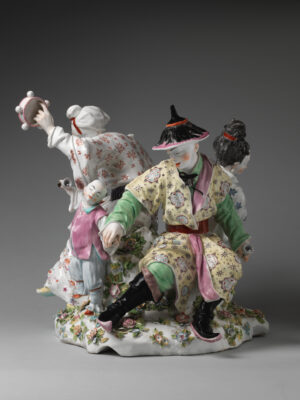
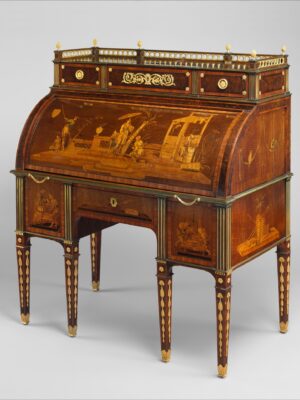
Being labelled ‘Chinese’ in the West means being associated with a Western idea of ‘Chineseness.’ For us, the Chinese diaspora in the West, identity formation is intimately tied up with this idea of ‘Chineseness,’ and further how it manifests aesthetically. I believe that the stylistic, decorative, and sartorial are powerful communicators of value and desirability. ‘The foreign object is valued, after all, for its embodiment of cultural character’ (Yang 2002, 339). How are the values of chinoiserie consolidated within people who can be categorised as ‘in the Chinese taste’? Chinoiserie is moulded not in the image of China proper, but in the image of marketable cultural difference. It materialises in silks, porcelain, jade, lacquered wood, red cinnabar paste, stone seals, and mother of pearl.
Initially, my chinoiserie-induced object-kinship made me feel shallow, inauthentic, and obsessed with surface splendour. I felt like an 18th-century British consumer of chinoiserie—not a Chinese person. Was this admiration of an exaggerated depiction of Asianness not a most European tendency of mine? Had I been westernised to a point of no return?
I’ve since come to recognise these feelings as stemming from exactly the same narrative that chinoiserie is predicated upon: the marketability and value of cultural difference as dependent on a binary relationship between East and West, the two terms being mutually exclusive. Shifting perspective, I want to propose a reading of chinoiserie as subversive and innately hybrid, able to undermine this essentialising and reductive East-West dichotomy.
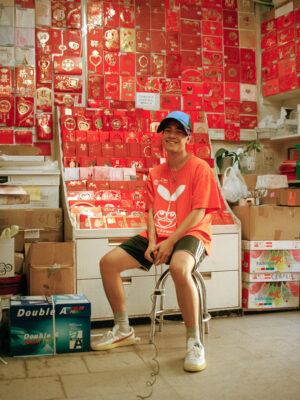


It is noteworthy that the aesthetics of chinoiserie were produced out of a trade relationship of objects circulating between Asia and Europe. China, for instance, had been producing objects for a European market since the early 18th century, the aesthetics and quality of which differed from production for a local market. Goods arriving in Europe were thus not plucked from the same shelves that would reach local customers. Their stylistic renderings had already been meddled with and often looked foreign to both contemporary European and Chinese eyes. Chi-ming Yang calls chinoiserie ‘imaginative rather than imitative’ (Yang 2002, 340), produced out of an intricate exchange network of goods, values, ideas, and aesthetics propagating between East and West. In other words, these aesthetics are not equal to original and copy, but rather eviscerate such a one-way relationship: ‘Through a complex process of back-and-forth (and back) imitations, original and copy are in fact no longer locatable’ (Yang 2002, 341). Developing as a result of cultural exchange and entanglement, chinoiserie manifests as distinctly hybrid. Although consumed in Europe as ‘in the Chinese taste,’ chinoiserie is slippery and elusive, a fever dream of signifiers pointing East and West.
In this way, chinoiserie materialises as an emblem of the fragmented, disjointed, and mutable, defying categorisation. By extension, the diasporic Asian body can contain those same subversive qualities—defying categorisation.
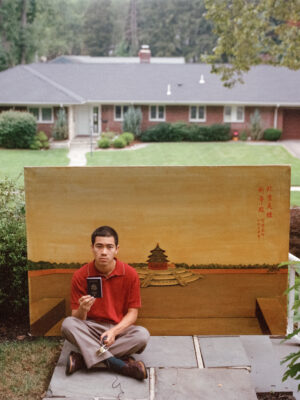
In Anne Anlin Cheng’s Ornamentalism (2018), ‘the yellow woman’ is defined not as ‘the real Asian […] woman but instead the very real formation of her ghost in Euro-American culture’ (Cheng 2018, xii, emphasis added). Cheng asserts that while the gendered and racial processes that animate Asiatic femininity through aesthetics are certainly oppressive, objectifying, and reductive, they also reveal a powerful perspective on the synthesis of organic matter and synthetic matter in the fabrication of the human. Cheng explicates how synthetic objects are not just related to Asiatic femininity but become its very constituents. In this way, the yellow woman materialises as a hybrid creature, papier-mâchéd together from biological matter and the silks, porcelain, and lacquered wood that too make up the material of my being, lodged in the crevices of my skin and bones and flesh. In her kinship with objects and her hybrid nature as not wholly Western, not wholly Eastern, not wholly human, and not wholly object, the yellow woman exposes to us how the narrative of the human always exists in a complex fandango with synthetic matter—with objects, with the sartorial, decorative, ornamental, and adorning. Rather than true, natural, biological creatures frolicking on God’s green earth, our bodies are encoded with objects and non-human material. The yellow woman is a Chinese fake and a fake Chinese, undermining the very concepts of authenticity, original, and copy. She exists somewhere that oscillates rapidly between real and fake, Eastern and Western—both flesh and not.
The shine, gleam, and allure of exotic Asian objects is a visual language, one that can be appropriated and utilised. I see this tendency in my own practice as an artist and jewellery maker. I see in the works of myself and other artists of the Chinese diaspora how we enter into conversation with these objects of ‘the Chinese taste.’ There is a disruption of the narrative when the decorative object starts to adorn itself, when the Asian body begins to comment on its own Asianness. Surrounded by these emblems of Asiatic personhood, they become malleable in our hands. The subject-object divide collapses and the Chinese caricature becomes the author of her own plot.
Bibliography
- Cheng, Anne Anlin. Ornamentalism. New York: Oxford University Press, 2019.
- Sloboda, Stacey. Chinoiserie: Commerce and Critical Ornament in Eighteenth-Century Britain. Studies in Design. Manchester New York: Manchester university press, 2014.
- Yang, Chi-ming. “Virtue’s Vogues: Eastern Authenticity and the Commodification of Chinese-Ness on the 18th-Century Stage.” Comparative Literature Studies 39, no. 4 (2002): 326–46. http:// www.jstor.org/stable/40247363.
Cover image
‘Exotic Commodities’, isabel wang pontoppidan & James Bowie, 2021.
isabel wang pontoppidan is a writer, artist & jewellery maker. through different lenses of narrativisation, diaspora and commodification, isabel explores the nature of humans as hybrid creatures, composed of biology, objects and ideas—both flesh and not.
